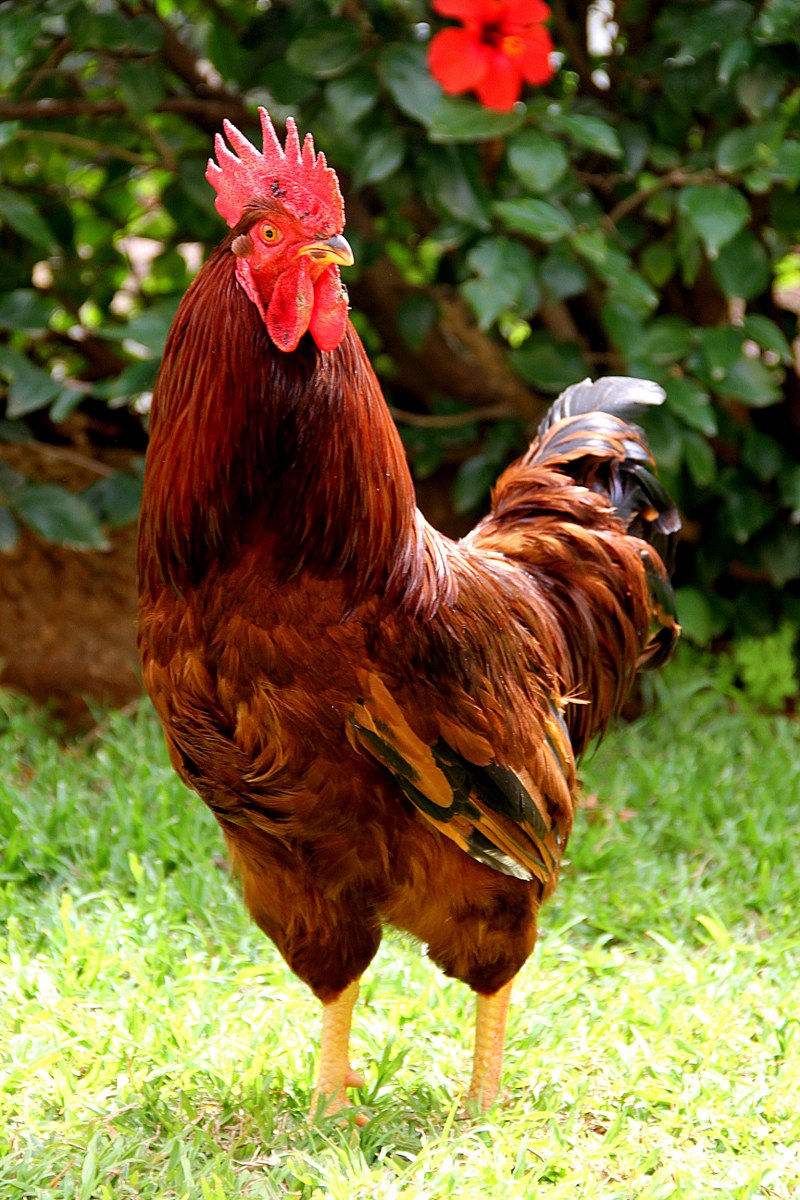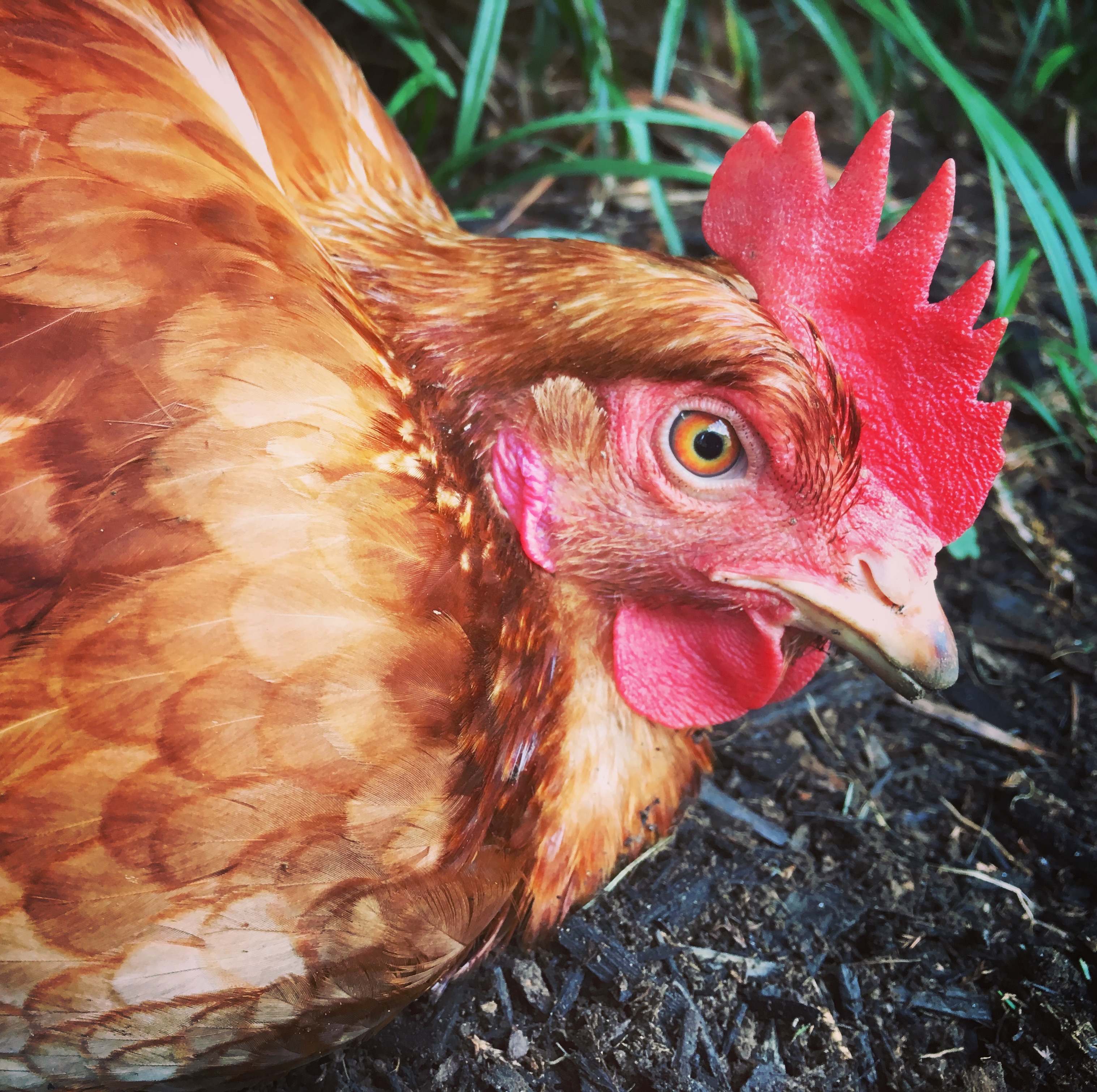 One of the first chickens I ever owned was a big Rhode Island Red rooster named…what else? Red! I got him out of a feed bin at the local farm store when I was 14. The fluffy little orange chick turned out to be one of the meanest chickens I’ve ever known to this day. I’d take a leaf rake with me to the coop to guard my legs against his sharp thick spurs.
One of the first chickens I ever owned was a big Rhode Island Red rooster named…what else? Red! I got him out of a feed bin at the local farm store when I was 14. The fluffy little orange chick turned out to be one of the meanest chickens I’ve ever known to this day. I’d take a leaf rake with me to the coop to guard my legs against his sharp thick spurs.
Even though Red was a jerk…I still think of him with fondness. He was a beautiful bird, and, up until the age of 3, something of a sweetheart. It’s weird the way roosters will just change personality. I’m sure it was some complicated hormonal instinct paired with the socialized pecking order of flock social status… but still, it hurt my young chicken-keeper feelings that my sweet little man had turned into a ruthless, rearing attack chicken.
Red met his end in a coyote attack. His wing had been broken and he had suffered many injuries. My dad and I decided that the most humane thing would be to put him down.
He was the first living creature I ever killed. It was out of mercy, but I’ll never forget it.
 Because of Red, Rhode Islands have always held a special place in my heart. They are like the apple pie of chicken breeds. The All American baseball breed. And because of that, I’m planning on visiting the Ohio National Poultry Show this fall to find a breeding pair.
Because of Red, Rhode Islands have always held a special place in my heart. They are like the apple pie of chicken breeds. The All American baseball breed. And because of that, I’m planning on visiting the Ohio National Poultry Show this fall to find a breeding pair.
So why…you might ask, am I traveling 5 hours away to find a pair of breeding Rhode Island Reds when every farm store in America will be getting in dozens of these birds this spring?
Good question, and hopefully I can answer that below.
The Rhode Island Red history
-Livestock Conservancy
 Rhode Island Reds were created as a dual-purpose breed meaning that they reached a decent table size the females weighing in at 6 and the males 8. They are also very good egg layers. They lay a nice large brown egg, the quintessential large brown egg.
Rhode Island Reds were created as a dual-purpose breed meaning that they reached a decent table size the females weighing in at 6 and the males 8. They are also very good egg layers. They lay a nice large brown egg, the quintessential large brown egg.
“Real” Rhode Island Reds
Red, the rooster I brought home from the feed store, was a beautiful brick red bird. His orange-y feathers shone golden and rust in the sunlight. He had a bright red comb and wattle and his tail was a deep iridescent mix of green and blue. He was stunning. But he was a hatchery bird. As the Livestock Conservancy quote above explains, he was not the “old-type”.
 “Real” Rhode Island Reds, the heritage breeds that are bred closer to the Standard of Perfection are a deep mahogany color, burgundy, wine and bordering on plum. They are spectacular to see one at a poultry show! These are the ones I’m after!
“Real” Rhode Island Reds, the heritage breeds that are bred closer to the Standard of Perfection are a deep mahogany color, burgundy, wine and bordering on plum. They are spectacular to see one at a poultry show! These are the ones I’m after!
Hatchery Rhode Island Reds are technically real RIRs but you won’t often find the deep color or size that the heritage bred ones boast.
“Red” Layers
Often, in the spring you might find a bin of chicks for sale labeled “Red Layers”. This is often a mix of different chicken breeds that may include Rhode Island Reds. It could also include New Hampshire Reds, Isa Browns, Cinnamon Queens, Red Sex Links and more.
These Red Layers have similar genetic makeups and all are good producers of large brown eggs. So if you’re not interested in the breed standards and just want a nice collection of good layers, this might be a good choice. Sometimes these Red Layers are a mix of the different breeds, and sometimes they are interbred “mutt” birds. Either way, you should get a nice collection of brown eggs through these chickens.













6 Comments
Just want to tell you I enjoyed your story about red so much
Have 6 reds myself raised them from one day olds
Tough chickens
Survived -18C last night
Huge eggs sometimes
https://www.communitychickens.com/wp-content/uploads/2019/01/Rhode_Island_Red_cock2C_cropped.jpg
I need one rooster like this one.
We love this breeds and 10000 birds at our Farm.
this breeds and 10000 birds at our Farm.
Just Two bird for this layer breed & roosters , Marvelous. & wonderful.
We love this breed.
Regards
CHEEMA FARM POULTRY AND PRODUCTS
J&K, INDIA. 181101.
There so beautiful I just love them all
I’m curious if there is way to tame a mean RIR rooster? Mine is starting to show feisty behavior but I’m wondering if it’s because he can’t get to my 6 week old hens yet. He adopted me after a neighbor stopped caring for him. He is almost 2 years old. I was hoping to eventually incubate fertilized eggs but I do not want a mean rooster. I also want to keep them the same breed. Any ideas on taming him back to the way he was before he got feisty?
No, the more competion they have the worst the behavior can become